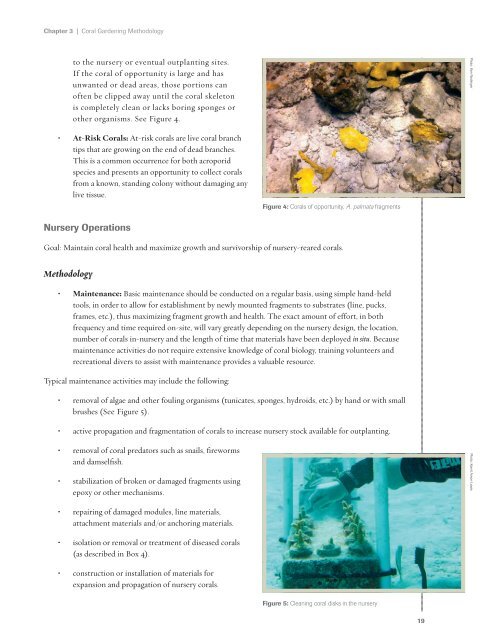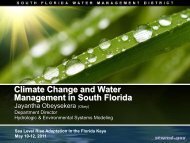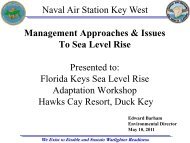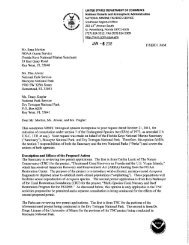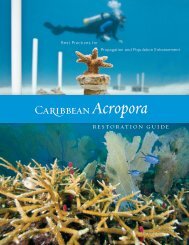Caribbean Acropora Restoration Guide - The Florida Reef ...
Caribbean Acropora Restoration Guide - The Florida Reef ...
Caribbean Acropora Restoration Guide - The Florida Reef ...
You also want an ePaper? Increase the reach of your titles
YUMPU automatically turns print PDFs into web optimized ePapers that Google loves.
Chapter 3 | Coral Gardening Methodology<br />
to the nursery or eventual outplanting sites.<br />
If the coral of opportunity is large and has<br />
unwanted or dead areas, those portions can<br />
often be clipped away until the coral skeleton<br />
is completely clean or lacks boring sponges or<br />
other organisms. See Figure 4.<br />
• At-Risk Corals: At-risk corals are live coral branch<br />
tips that are growing on the end of dead branches.<br />
This is a common occurrence for both acroporid<br />
species and presents an opportunity to collect corals<br />
from a known, standing colony without damaging any<br />
live tissue.<br />
Nursery Operations<br />
Goal: Maintain coral health and maximize growth and survivorship of nursery-reared corals.<br />
Methodology<br />
• Maintenance: Basic maintenance should be conducted on a regular basis, using simple hand-held<br />
tools, in order to allow for establishment by newly mounted fragments to substrates (line, pucks,<br />
frames, etc.), thus maximizing fragment growth and health. <strong>The</strong> exact amount of effort, in both<br />
frequency and time required on-site, will vary greatly depending on the nursery design, the location,<br />
number of corals in-nursery and the length of time that materials have been deployed in situ. Because<br />
maintenance activities do not require extensive knowledge of coral biology, training volunteers and<br />
recreational divers to assist with maintenance provides a valuable resource.<br />
Typical maintenance activities may include the following:<br />
• removal of algae and other fouling organisms (tunicates, sponges, hydroids, etc.) by hand or with small<br />
brushes (See Figure 5).<br />
• active propagation and fragmentation of corals to increase nursery stock available for outplanting.<br />
• removal of coral predators such as snails, fireworms<br />
and damselfish.<br />
• stabilization of broken or damaged fragments using<br />
epoxy or other mechanisms.<br />
Figure 4: Corals of opportunity, A. palmata fragments<br />
Photo: Ken Nedimyer Photo: Kemit Amon-Lewis<br />
• repairing of damaged modules, line materials,<br />
attachment materials and/or anchoring materials.<br />
• isolation or removal or treatment of diseased corals<br />
(as described in Box 4).<br />
• construction or installation of materials for<br />
expansion and propagation of nursery corals.<br />
Figure 5: Cleaning coral disks in the nursery<br />
19


